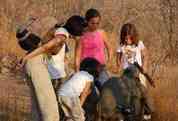What’s a Namibia Desert safari like? Explore the Namib, Karoo & Kalahari Deserts
Namibia, renowned for its stunning desert landscapes, is one of southern Africa’s most popular safari destinations. Vast open spaces, towering orange-red sand dunes, shaggy plants that have survived for thousands of years, and specialist desert-adapted game, combined with quaint colonial architecture, and fascinating local cultures make Namibia an African safari gem. Exploring Namibia means exploring African desert landscapes. But how many deserts are there in Namibia? Where does the sand come from, and what life can you expect to find in the Kalahari, Karoo, and Namib Desert? This blog post will explain the Namibia deserts, and offer a window into this fascinating world.
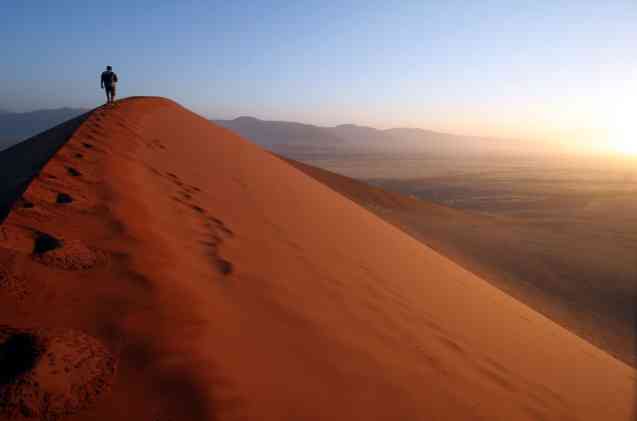 Hike up Dune 45 Sossusvlei, Namibia
Hike up Dune 45 Sossusvlei, Namibia
What is a desert?
From Mongolia to the Americas, Australia, and Africa, deserts are found around the globe. A desert is defined as a dry, barren region that receives less than 25cm or 10 inches of rain per year. They are often characterized by hot daytime temperatures, cold temperatures at night, a lack of trees, and very sparse vegetation, as well as low densities of animal life. Remarkably, deserts cover approximately one-third of the earth's land surface.
Despite popular belief, deserts are not barren wastelands. They are biologically diverse habitats, with a host of unique plants and animals that have adapted to survive in harsh conditions. Some deserts are among the last remaining areas of total wilderness on the planet. Namibia, located in southern Africa, is known for its stunning desert landscapes, but how many deserts are there in Namibia?
 African desert safari in Namibia
African desert safari in Namibia
How many deserts are there in Namibia?
Namibia is renowned for its striking African desert landscapes. But just how many deserts are there in Namibia? Namibia is blessed with four distinct desert ecosystems which are the Namib, the Kalahari Desert, the Succulent Karoo, and the Nama Karoo. Because of the higher-than-average rainfall in the Succulent Karoo, Nama Karoo, and Kalahari, they are not, by a strict definition, true deserts.
The Namib Desert is the most famous and covers most of Namibia's coastline, with its iconic red dunes and diverse wildlife. The Kalahari Desert, because of its slightly higher rainfall, is actually a semi-arid region that stretches across southern Africa. The Succulent Karoo and the Nama Karoo are lesser-known desert ecosystems that are characterized by their otherworldly landscapes and specialized flora and fauna. Each desert ecosystem in Namibia offers a unique and captivating experience for travellers, and exploring its diverse features is a must-do for anyone visiting this beautiful country.
The Namib Desert in Namibia
The Namib Desert is a fascinating and captivating landscape located in southwestern Africa. It is considered the oldest desert on Earth, with its sands believed to be around 5 million years old. The Namib Sand Sea, a vast section of the desert that spans 34,000 km² (13,000 mi²), is home to many of the highest dunes on the planet. These dunes, sculpted by winds, are a highlight of the Namib Desert, and a must-see for any Namibian desert safari.
The sand that makes up the Namib Desert originates from erosion processes that occur to the south of the area, near the Orange River valley. The Orange River carries sandy sediment into the Atlantic Ocean, and northward flowing currents deposit it along the shore. The prevailing winds from the south also contribute to the deposition of sand in the desert. This process results in the unique landscape of the Namib Desert, with its towering dunes that stretch as far as the eye can see.
Despite the harsh environment, life has found a way to survive in the Namib Desert of Namibia. The fog that rolls in from the ocean is the primary source of water for the region, making it the only coastal desert in the world to contain large dune fields influenced by fog. This moisture results in relatively abundant and diverse vegetation, particularly on the rocky hills or mountains (inselbergs) that rise above the desert.
 Namib web-footed gecko, Namibia
Namib web-footed gecko, Namibia
The Namib Desert Adapted Wonders |
|---|
|
The Namib Desert is home to an unexpected variety of fauna and flora, including the endemic Namib Desert beetle, elusive and endangered desert lions, and elephants, as well as oryx, cheetahs, hyenas, foxes, Haartman’s zebras, and Namibia’s national plant, the Welwitschia which can survive for thousands of years. The wild horses of the Namib Desert are an iconic feature of Namibia, thought to have escaped from German cavalry during World War II.
In addition to its natural wonders, the Namib Desert has a rich cultural history, with evidence of human habitation dating back over 2,000 years. The indigenous people of the desert, including the Himba and the Herero, have a deep connection to the land and have developed unique cultures and traditions that are still practised today.
The Namib Desert is a popular desert adventure destination. Highlights include the iconic Sossusvlei, a salt and clay pan surrounded by towering red dunes, including the famous Dune 45 and Big Daddy, the tallest dune in the Namib Desert. Dune 7, another prominent dune, is located in the Namib-Naukluft National Park and is a popular spot for sandboarding. The Namib Desert is also an incredible place for enjoying the galactic wonder of the Milky Way, and the Namib Desert is home to Africa’s only Dark-Sky Reserve at the Namib-Rand Private Reserve.
The unique and awe-inspiring Namib Desert is filled with stunning natural features, rare and fascinating flora and fauna, and rich cultural history. It is a must-see destination for anyone interested in exploring the wonders of the natural world.
TOP Namib Desert Destinations & Activities |
|---|
|
Top Namib Desert Park: The Namib-Naukluft National Park
The Namib-Naukluft National Park is a vast wilderness covering 50,000 km² in the Namib Desert. The park boasts a stunning array of plant and animal life adapted to survive in a harsh environment with very little water. It is home to shifting terracotta dunes, vast plains, and the dramatic Naukluft Mountains. Wildlife includes oryx, kudu, giraffe, springbok, black-backed jackals, African wild cats, aardvarks, and leopards, along with over 340 species of birds and many reptiles. The park also features weird and wonderful plants like the Welwitschia. The dunes in the park are massive, with some reaching heights of over 300 meters creating an awe-inspiring desert landscape.
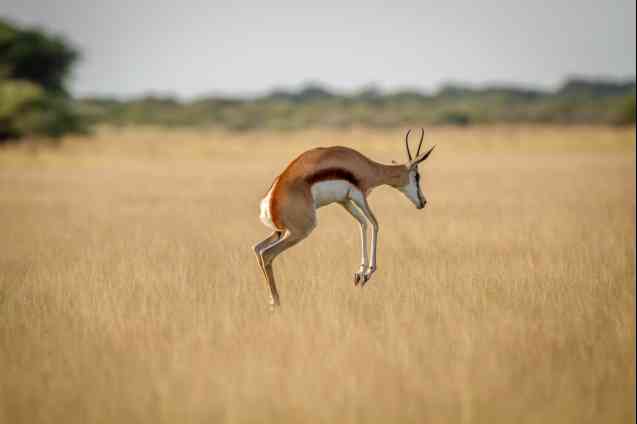 Springbok in Kalahari Desert, Namibia
Springbok in Kalahari Desert, Namibia
The Kalahari Desert in Namibia
The Kalahari is a vast semi-arid region that covers over 900,000 km² across southern Africa, including parts of Namibia, Botswana, and South Africa. The Namibian section of the Kalahari Desert lies in the eastern and southern parts of the country, where it merges with the Namib. The Kalahari Desert is Africa’s second largest desert after the Sahara. This African desert was formed over 60 million years ago during the break-up of the Gondwana supercontinent, which caused the climate to become drier.
Despite the Tswana name which means “the great thirst”, the Kalahari Desert is not a true desert, as it receives slightly more rainfall than a typical desert. However, the water either sinks below the sand or evaporates due to the extreme heat. The sand in the Kalahari Desert is not blown in from the coast like the Namib but is rather the result of the erosion of the surrounding rock formations. The sand dunes in the Kalahari are generally not as large or as steep as those in the Namib Desert, but they still create an impressive landscape of red sand and sweeping vistas.
The Kalahari Desert is full of life that includes desert-adapted species like oryx, springbok, wildebeest, and kudu, as well as African desert specialists like meerkats, bat-eared foxes, cape foxes, and brown hyenas. Interestingly, the Kalahari Desert is also home to all three of Africa’s big cats, the cheetah, leopard, and the famous Kalahari black-maned lions. In addition to the game species, the Kalahari is also home to an array of birdlife that includes ostriches, secretary birds, kori bustards, and impressive sociable weavers.
The San people, also known as Bushmen, have lived in the Kalahari Desert for thousands of years and are believed to be one of the oldest cultures in the world. The San adapted to the harsh environment by developing a deep understanding of the natural world around them and relying on hunting and gathering for survival. Amongst the fascinating medicinal plants of the Kalahari is the Hoodia, a euphorbia species that when ingested relieves fatigue and hunger. Visitors to the Kalahari Desert can learn about San culture and history through guided tours and cultural experiences.
 Black maned lion Kalahari Desert
Black maned lion Kalahari Desert
| TOP Kalahari Desert Destinations & Activities |
|---|
|
Best Kalahari Desert Park: The Kgalagadi Transfrontier Park
The best national park to visit in the Namibian Kalahari is the Kgalagadi Transfrontier Park, which straddles the border between Namibia, South Africa, and Botswana. The park is a vast wilderness area of over 3.6 million hectares and is home to an incredible variety of wildlife, including lions, cheetahs, leopards, and hyenas. Visitors can stay in comfortable lodges or camp out under the stars and enjoy game drives and guided walks to see the wildlife and experience the unique landscape of the Kalahari Desert.
The Nama Karoo & Succulent Karoo of Namibia
The Nama Karoo and Succulent Karoo cover vast tracks of land that stretch from southern Namibia southward into the Western Cape of South Africa. These semi-desert eco-regions are distinct because of their unique climatic conditions and highly adapted plant species. For most people, there is little difference between the Nama Karoo and the Succulent Karoo, but to those willing to explore, these biomes offer a wealth of distinct animal and plant life, as well as a fascinating record of the history of the earth.
The Nama Karoo of Namibia
The Nama Karoo is a vast, arid region characterized by low-shrub vegetation and rugged terrain. It covers an area of approximately 135,600 km² (52,400 sq mi). Despite not having high species richness or endemism, the flora and fauna have impressively adapted to the extreme climate of the region. Unfortunately, the region faces major threats to its biodiversity due to pastoralism, exotic plants, mining, and agriculture, while less than 1% of the ecoregion has conservation status. Mostly, the Nama Karoo is covered by huge sheep farms where sheep have replaced the huge grazing migratory herds of springbok that naturally occurred more than a century ago. The prevailing vegetation in the area is grassy, dwarf shrubland. The Nama Karoo is not a tourist hotspot.
The Succulent Karoo of Namibia
The Succulent Karoo is unparalleled in its botanical diversity among all arid regions globally. Covering over 100,000km², the area extends from southern Namibia south, across the Orange River, and into South Africa. This area is the richest region of succulent flora globally and boasts over 5,000 species of which 40% are endemic. Some of the most well-known succulents found in the area include the quiver tree, the "half-mens" tree, and the hugely diverse Mesembryanthemum family of plants. The Succulent Karoo is also home to a variety of wildlife, including Hartmann's mountain zebra, and many species of birds. The Succulent Karoo is a treasure trove of desert-adapted species of succulents, geophytes, reptiles, and unique insects like monkey beetles. Only about 3% of this ecoregion has protected status.
 Ai Ais Richtersveld National Park
Ai Ais Richtersveld National Park
TOP Succulent Karoo Destination: Ai-Ais-Richtersveld Transfrontier Park
The best place to experience the unique biodiversity of the Succulent Karoo is the Ai-Ais-Richtersveld Transfrontier Park, which straddles the border between Namibia and South Africa. The park is home to a diverse range of wildlife, including mountain zebras, klipspringers, and several species of antelope. Visitors can explore the park on foot, by vehicle, or on a guided tour, and there are a variety of accommodation options available, from camping to luxury lodges.
The Richtersveld is home to an outstanding array of plant life, with over 2,700 species, half of which are endemic to the region. The unique and diverse plant life is due to the harsh climate and geology of the area. The region's plants have adapted to survive in extreme temperatures and drought, including the well-known "half-mens" plant, which resembles a human figure. Other notable plants include the tall quiver tree, and the Namaqua fig, which is used by locals to produce a delicious jam. The Richtersveld's plant diversity is so exceptional that it was declared a UNESCO World Heritage Site in 2007.
 Mesembrantheum family of flowers
Mesembrantheum family of flowers
| Top Nama & Succulent Karoo Attractions |
|---|
|
Namibia Desert Safari
Visiting Namibia on a desert safari adventure (be it to the Namib Desert, Karoo, or the Kalahari) is an excellent way to explore these truly unique biomes. With big skies, endless horizons, and a multitude of fascinating experiences, Namibia has a lot to offer every traveller, African Budget Safaris has over a hundred Namibia safaris to choose from or talk to one of our experienced travel consultants today, and start planning your Namibia desert safari.
If you liked this post, these trips cover similar ground…
- 3 Day Private Namibia Safari to the Namib Desert
- 4 Day Swakopmund & Namibia Desert Private Safari
- 5 Day Private Namibia Desert & Swakopmund Safari
- 10 Day Explore Namibia Private Safari Tour
- Budget Namibia Desert Lodge Safari
- Private Namibia Desert, Swakopmund & Etosha Safari
- Namibia Desert Safari (Budget Lodge Tour)
- Namibia Desert & Botswana Delta Safari
- Sossusvlei Namibia Safari - Budget Camping Tour
- 12 Day Namibia Self Drive Safari
- 7 Day Big Cats, Etosha & Desert Namibia Safari









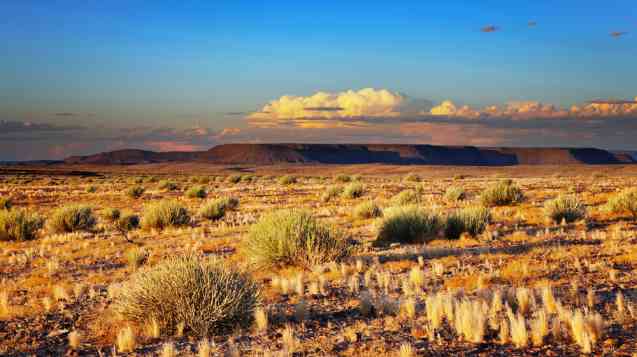
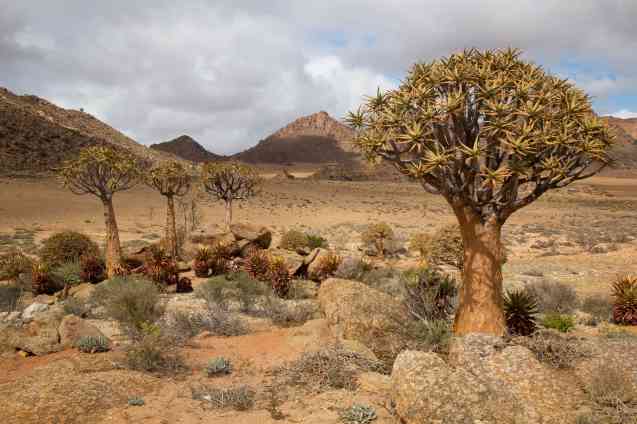

 On the outskirts of Marloth Nature Reserve, Andrew can be found walking and swimming in the beautiful Langeburg Mountains. He is passionate about animals, birds, reptiles, and plants and loves nothing more than an adventure in nature. An established artist with a master's in English literature, Andrew has traveled far and wide but South Africa still has his heart.
On the outskirts of Marloth Nature Reserve, Andrew can be found walking and swimming in the beautiful Langeburg Mountains. He is passionate about animals, birds, reptiles, and plants and loves nothing more than an adventure in nature. An established artist with a master's in English literature, Andrew has traveled far and wide but South Africa still has his heart.








